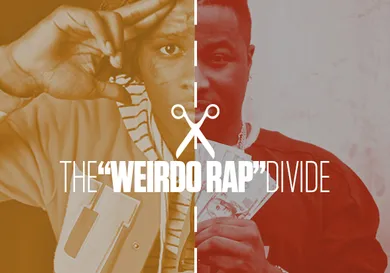50 Cent and G-Unit made headlines following this year's Summer Jam for a very visible fight that took place in front of 50,000 viewers (70,000 if you count those online) on the event's mainstage. But outside of that seconds-long scuffle, there was a bigger, albeit more subterranean, conflict going on throughout the daylong event. It may not have been apparent to all those in attendance, but this year's Summer Jam saw some passive-aggressive head-butting between two camps that have been growing in the past few years: hip-hop traditionalists and the new-school artists who some have deemed "weirdo rappers."
Kicking off on the mainstage, the main perpetrator of those "weirdo rap" comments, Troy Ave, was taking shots before he even stepped onstage. Airing a promotional video in which he defined his own legacy ("It goes Big, Jay, then Troy Ave"), the Crown Heights, Brooklyn MC also threw up a picture of Trinidad James and sneeringly said, "Trinidad James -- that's just a weirdo rapper," as if that was reason enough for any sane hip-hop fan to write him off.

Between sets, a whole host of Hot 97 DJs spun short snippets of tracks to keep the crowd amped. Though they interspersed classics with more modern turn up anthems, every smidgen of old-school was seemingly introduced with the signifier that it was "real rap" or "real hip-hop." "This is what real hip-hop sounded like before it went ratchet," said DJ Mister Cee numerous times, before throwing on "Lunchini," or "Shook Ones Pt. II" or "Let Me Clear My Throat," or any number of other songs in the Hot 97-approved NYC hip-hop canon. As Rolling Stone put it, "The disappointment in [Mister Cee's] voice was audible as he longed for a time before hip-hop decentralized."
Then came Nas, whose Illmatic 20th anniversary set was cut short by a pair of younger rappers: Meek Mill and French Montana. Introducing the former, Nas got passionate when he yelled: "I only love niggas that come from the hood. That's all I fucking love!" Perhaps speaking out against Summer Jam artists like Iggy Azalea, Childish Gambino, Wiz Khalifa, Jhené Aiko and Questlove, who all come from less impoverished backgrounds, the former Queensbridge Houses resident made his point clear: the hood is where hip-hop started, and that's where it should stay.
All three of those shots took aim at a different aspect of the new generation of rappers -- Troy Ave's at their style and appearance, DJ Mister Cee's at their sound, and Nas' at their social and economic background -- so clearly we need to investigate this divide more closely. Of course, not all of these complaints were necessarily directed at cut-and-dry "weirdo rappers," all of them stemmed from a widening gap between artists who follow the classic hip-hop path to success, and those whose fame is a product of a new era of hip-hop. 20 years ago, someone who looked like Trinidad James, incorporated electronic music into their beats, and hailed from the suburbs would not have made it as a rapper. Straight up. All you need to do to spot this is look at past Summer Jam lineups.
- In 1994, the concert's first year, the street-hardened Wu-Tang Clan shared the stage with more socially conscious artists like Arrested Development and A Tribe Called Quest, but apart from all-girl R&B group SWV, there wasn't huge variation between the sounds of all artists present.
- Fifteen years ago, Q-Tip and DMX represented the two contrasting poles of Summer Jam, with "One Love"-style optimism meeting "It's Dark and Hell is Hot"-style ferocity. But beyond that, both came from NYC outskirts and both went on to work with Jay Z -- even though they sounded worlds apart, they ran within the same circles.
- Ten years ago, the Kanye West/50 Cent rivalry that later went on to fuel an album-selling competition represented the yin and yang of that particular Summer Jam, but again, the differences in sound were minimal. Fiddy rose to fame with a roster of Dr. Dre beats at his disposal, and Kanye was riding high off a debut album that had Dre's "Xxplosive" to thank for most of its drum tracks.
- In 2009, the "weirdo" had just begun its rise, with Asher Roth (who was more of a "frat rapper" than a "weirdo" at the time, but he was getting there) hitting the Festival Stage, and this year, Gambino, Action Bronson, Young Thug and A$AP Ferg all showed up, with their alternative stylings letting the world know that hip-hop was changing.
Variation, in terms of sound, style and background, has increased in hip-hop in the past 20 years (as can be said for almost any genre of music in a 20-year period), but where exactly do these new artists diverge from the tried-and-true model of old-school hip-hop? Beyond that, are their various forms of rule-breaking dangerous to the genre?
By breaking down the concept of the "weirdo" into four categories: sound, social/economic/regional, drugs and appearance/sexual orientation, we'll unpack this question. Read on by clicking on images in the galleries above.
